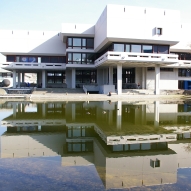| Dokumentenart: | Artikel | ||||
|---|---|---|---|---|---|
| Titel eines Journals oder einer Zeitschrift: | Neuropharmacology | ||||
| Verlag: | PERGAMON-ELSEVIER SCIENCE LTD | ||||
| Ort der Veröffentlichung: | OXFORD | ||||
| Band: | 113 | ||||
| Seitenbereich: | S. 343-353 | ||||
| Datum: | 2017 | ||||
| Institutionen: | Biologie und Vorklinische Medizin > Institut für Zoologie > Molekulare und Zelluläre Neurobiologie (Prof. Dr. Peter J. Flor) | ||||
| Identifikationsnummer: |
| ||||
| Stichwörter / Keywords: | CEREBROCORTICAL NERVE-TERMINALS; LONG-TERM DEPRESSION; MEDIAL PREFRONTAL CORTEX; MGLU7 RECEPTOR; BETA-ARRESTIN; SYNAPTIC PLASTICITY; MICE LACKING; RAT-BRAIN; PSYCHIATRIC-DISORDERS; ADRENERGIC-RECEPTORS; mGlu7 receptors; alpha(1)-adrenergic receptor; Stress; Cross-talk; G proteins | ||||
| Dewey-Dezimal-Klassifikation: | 500 Naturwissenschaften und Mathematik > 570 Biowissenschaften, Biologie 500 Naturwissenschaften und Mathematik > 590 Tiere (Zoologie) | ||||
| Status: | Veröffentlicht | ||||
| Begutachtet: | Ja, diese Version wurde begutachtet | ||||
| An der Universität Regensburg entstanden: | Ja | ||||
| Dokumenten-ID: | 38790 |
 Web of Science
Web of ScienceZusammenfassung
We studied the interaction between mGlu7 and alpha(1)-adrenergic receptors in heterologous expression systems, brain slices, and living animals. L-2-Amino-4-phosphonobutanoate (L-AP4), and L-serine-O-phosphate (L-SOP), which activate group III mGlu receptors, restrained the stimulation of polyphosphoinositide (PI) hydrolysis induced by the alpha(1)-adrenergic receptor agonist, phenylephrine, in ...

Zusammenfassung
We studied the interaction between mGlu7 and alpha(1)-adrenergic receptors in heterologous expression systems, brain slices, and living animals. L-2-Amino-4-phosphonobutanoate (L-AP4), and L-serine-O-phosphate (L-SOP), which activate group III mGlu receptors, restrained the stimulation of polyphosphoinositide (PI) hydrolysis induced by the alpha(1)-adrenergic receptor agonist, phenylephrine, in HEK 293 cells co-expressing alpha(1)-adrenergic and mGlu7 receptors. The inibitory action of L-AP4 was abrogated by (i) the mGlu7 receptor antagonist, XAP044; (ii) the C-terminal portion of type-2 G protein coupled receptor kinase; and (iii) the MAP kinase inhibitors, U0126 and PD98059. This suggests that the functional interaction between mGlu7 and alpha(1)-adrenergic receptors was mediated by the beta gamma-subunits of the G(i) protein and required the activation of the MAP kinase pathway. Remarkably, activation of neither mGlu2 nor mGlu4 receptors reduced alpha(1)-adrenergic receptor-mediated PI hydrolysis. In mouse cortical slices, both L-AP4 and L-SOP were able to attenuate norepinephrine- and phenylephrine-stimulated PI hydrolysis at concentrations consistent with the activation of mGlu7 receptors. L-AP4 failed to affect norepinephrine-stimulated PI hydrolysis in cortical slices from mGlu7(-/-) mice, but retained its inhibitory activity in slices from mGlu4(-/-) mice. At behavioural level, i.c.v. injection of phenylephrine produced antidepressant-like effects in the forced swim test. The action of phenylephrine was attenuated by L-SOP, which was inactive per se. Finally, both phenylephrine and L-SOP increased corticosterone levels in mice, but the increase was halved when the two drugs were administered in combination. Our data demonstrate that alpha(1)-adrenergic and mGlu7 receptors functionally interact and suggest that this interaction might be targeted in the treatment of stress-related disorders. (C) 2016 Elsevier Ltd. All rights reserved.
Metadaten zuletzt geändert: 25 Nov 2020 15:45




 Altmetric
Altmetric